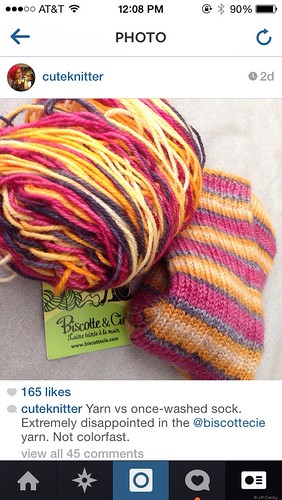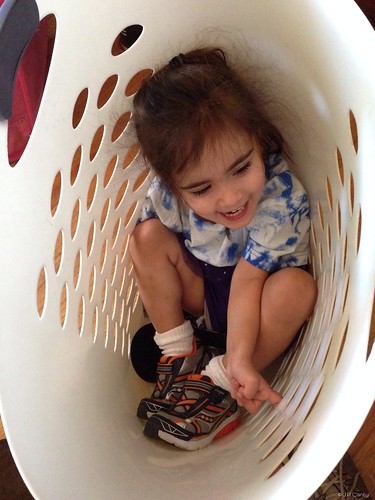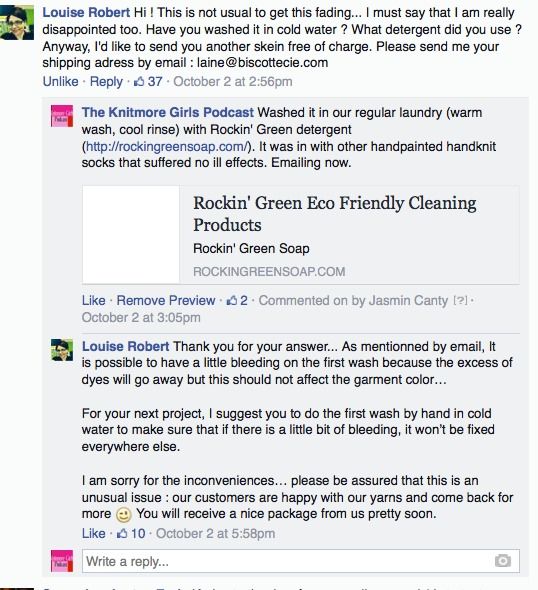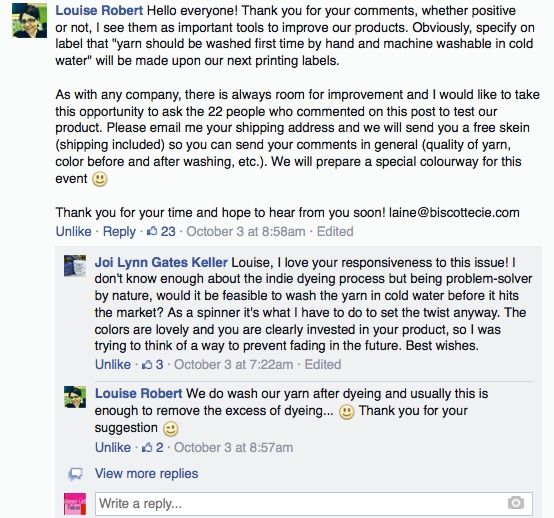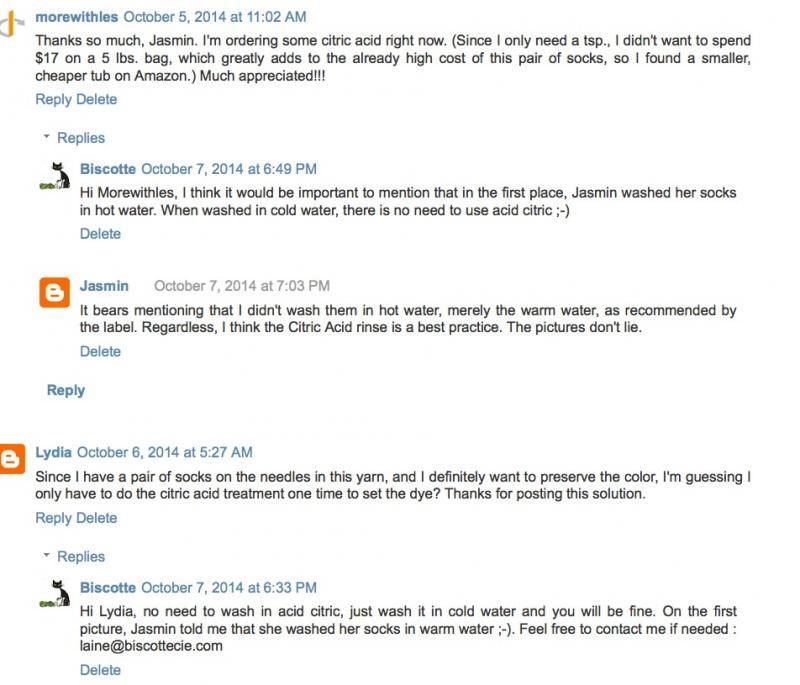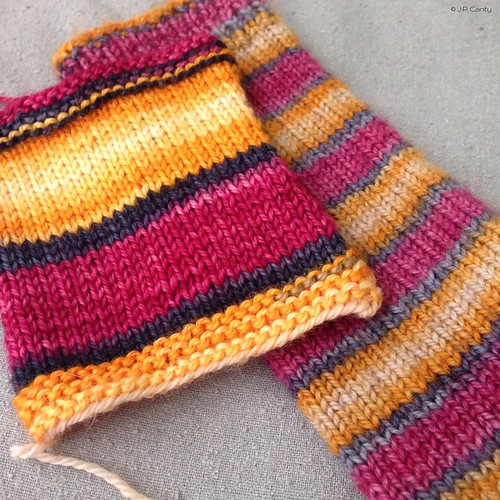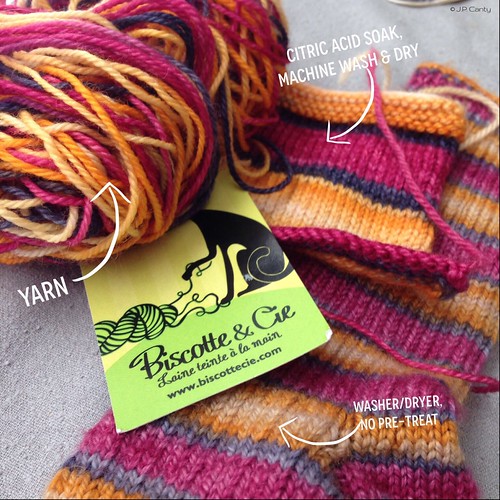We've all been there: you finish a pair of socks, wait three months, weave in the ends, wait for the weather to cool off, and FINALLY wear your beautiful socks. Then, if you're like me and have made a proclamation about *not* handwashing socks (and shopped for yarn accordingly) the next step is to throw them into the "wash with like colors" laundry basket.
Once the laundry is done, you go to fold the laundry and find that your vibrant, rich socks are now, well... not.
Disappointment doesn't even *begin* to describe how I've felt about it, especially given my recent (and drastic) reduction of crafting time. Add to that the guilt over having enabled a few other folks into buying the same yarn.
So, I Instagrammed and Facebooked about it.
I did this for several reasons. Let's start with the main one- I Instagram-med, Facebook-ed, Tweeted, and talked about these socks on the podcast for about two months during the 30-odd hours it took me to knit them.
Instagram and Facebook are strong enabling tools, and I have bought
I don't contact dyers privately before posting photos of my socks-in-progress, or when I finish socks. If I remember, I'll tag them in the photo, or tweet at them, because dyers are artists and like to see the fruits of their labor.
Podcast listeners frequently buy yarn they see on Facebook, Instagram, or Twitter based on what they see. It is for this reason I think it is even *more* important to show how the yarn washes and wears.
I would like to start by pointing out that the label tells you that machine washing is fine. Otherwise, I wouldn't have bought it. I have been known to be extremely vocal about *not* hand washing my socks.
I have a responsibility to my listeners. A company's response to quality issues should be public, visible, and accessible to its customers. Louise from Biscotte & Cie was *extremely* prompt in her response- responding mere *minutes* after I had made my post. [HUGE kudos, Louise & Biscotte & Cie.]
UPDATE/RETRACTION:
I wrote this post when I thought that the issue was done and handled. In the interest of being honest and transparent about the entire process, I am disappointed to have to include the following.
Within a day of the original solution (and blog post) Louise (the dyer) has gone from apologetic (on the podcast Facebook page- public) to aggressive in the comments field of my blog (public, but less visible). This includes changing what she says should be the care instructions, to a full out attack, alleging that I don’t know how to handle my woolens (including changing the story on how I launder to fit the individual she’s contacting). Screen caps, all from public places she’s posted, in order:
A superwash yarn should be machine washable and dryable, especially if the label says so. The re-statements above are clearly for the purpose of covering up her own short-cut, which is unprofessional and extremely poor business.
There are multiple comments about others having the same issue- regardless of laundering on our facebook page as well as on the original post on Instagram (you can see all the comments on the mobile app: http://instagram.com/p/tqmW-uLZRR/?modal=true). I was also contacted by other knitters via PM on Ravelry who had the same issue.
So, it’s a known issue. When I contacted the shop I bought the yarn from, to let them know about the issue with the yarn, the owner responded, "As I mentioned before, I haven’t had a need to do any dye-setting with the socks I’ve made out of Biscotte, so hopefully there are plenty of skeins out there that are just fine.”
The operative word there being “hopefully”. Given the response I saw on social media, “hopefully” really just isn’t. I don’t think the shop should be responsible for a dyer’s mix up, but there was no mention of letting other customers know that this is a known issue.
To sum up: the dyer is trying to brush this under the rug, and has no plans to change, and the shop selling the yarn is keeping quiet as well. I am not keeping quiet. As someone who promoted this yarn for two months while I knitted this yarn, I have a responsibility to every knitter I enabled to let them know there is both an issue and a solution.
As for the “solution” of sending me replacement yarn? I don’t want it. I want the socks I knit to be as promised in the skein, finished the way they should have been before the yarn reached the shop. Nobody offered to compensate me for the time lost, because they can’t.
Finally, as a customer I have no obligations to the company. I don't want to recommend a product that has problems. Our money and time are valuable commodities, and I can't in good conscience have my socks come out of the wash looking like they did, and leave it to the company to deal with. This is a much more transparent way of dealing with the problem, and showing the solution from the company's side.
[As an aside, when I've reported dye/felting/knot issues to companies before, I haven't seen *any* kind of public response. I have had *one* dyer do a pre-emptive public blast to her customers letting them know about a potential issue with bleeding, including a generous solution.]
There is value in posting to social media; mostly, social solutions. I am lucky to have many brilliant friends, including the incomparable Kate of Gourmet Stash. With nothing to gain personally, she devised a solution so that people who buy beautiful handpainted yarn can solve this issue on their own, preemptively.
So, there's chemistry.
Chemistry and I have a complicated history.
Fortunately for all of us, Kate broke it down to the simplest parts (after a lot of technical dye information). The following are her instructions (which I road tested and documented with photographs), which I have digested into four simple steps, with a few caveats.
---------------------------------------------------------
Fixing/Re-fixing dye:
The following is good for 4-6 oz of wool (so, a pair of socks, and then some):
Step 1: Take 1 tsp of Citric Acid
Step 2: Let the yarn soak for 10 mins or so and then wring out and "jelly roll" (wrap in plastic wrap
- Step 2a: Squeeze out excess water. Soak in SOAK wool wash
in cool water for 15 mins. Squeeze out excess water. (Water will be very pink. Breathe. It will work out.)
- Step 2b: Repeat the dyefix instructions in Step 1, *except* do 1/2 tsp Citric Acid instead of a full tsp.
- Step 2c: "Jelly Roll" (wrap in plastic wrap
), and microwave it for 2 mins on high.
- NOTE: For non-superwash yarns you would want to space out the heat via the microwave. (By that I mean, 1 minutes on heat, 1 minute off, etc. ). You can easily felt your yarn/fiber in a jelly roll format if you have the heat & steam get too high.
- CAUTION: If you microwave for too long on high, you can fuse the plastic saran wrap to the nylon content in yarn. (You want to be aware of the microwave you're using as well as how high the heat is and the length of time it is in the microwave.)
Step 3: Allow to dry.
Step 4: Launder as per usual.
Step 5: Rejoice.
You may notice that we did the citric acid soak on the swatch instead of on the yarn. That's to show that if you've already knit your socks, you can still treat them without worry.
This is also if you are overwhelmed with the need to start knitting your sock without a) fixing/re-fixing ("pre-treating") the dye on your yarn (just in case), or b) don't want to knit a swatch and launder normally to see if pre-treating is necessary.
And? The brilliant and lovely Kate said "I can't think of any reason why doing a basic citric acid soak and wring it out, jelly roll it up and nuke it for 2 mins for ANY [protein] fiber or yarn would be bad." [Said, with the above caveats, of course.]
